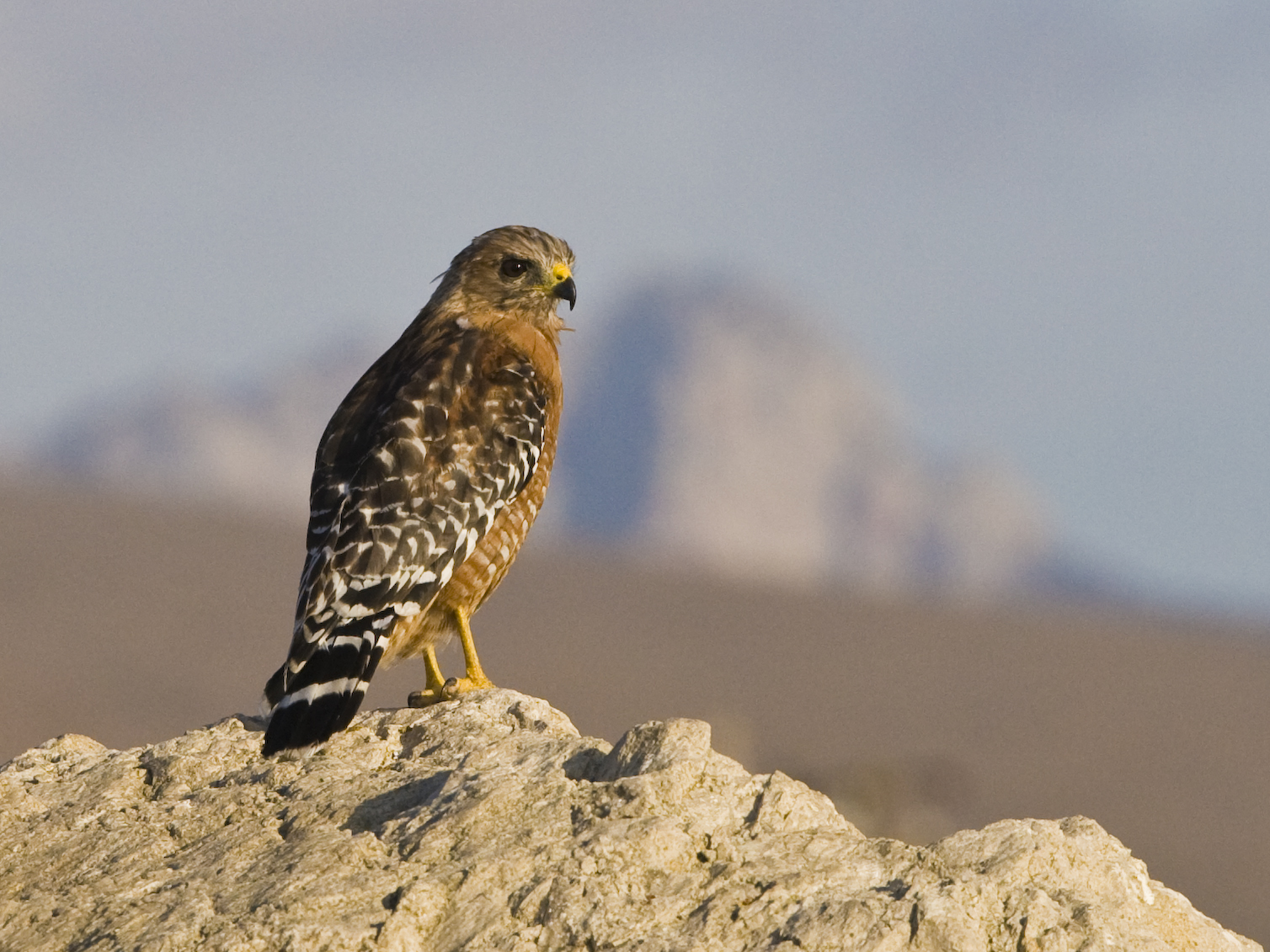- Red-shouldered Hawk
Taxobox
name = Red-shouldered Hawk
status = LC | status_system = IUCN3.1

image_width = 300px
regnum =Animal ia
phylum = Chordata
classis = Aves
ordo =Falconiformes
familia =Accipitridae
subfamilia = Accipitrinae
genus = "Buteo "
species = "B. lineatus"
binomial = "Buteo lineatus"
binomial_authority = (Gmelin, 1788)The Red-shouldered Hawk, "(Buteo lineatus)", is a medium-sized
hawk . Their breeding range is in easternNorth America and along the coast ofCalifornia and northernMexico ; also northeastern-central Mexico.Males are 43 to 58 cm (17 to 23 in) long, weigh about 550 g (1.2 lbs) and have a wingspan of 96 cm (38 in). Females are slightly larger at 48 to 61 cm (19 to 24 in) in length, a weight of about 700 g (1.5 lbs) and a wingspan of about 105 cm (42 in). Adults have a brownish head, a reddish chest and have a pale belly with reddish bars. Their tail, which is quite long by "
Buteo " standards, is marked with narrow white bars. The red "shoulder" is visible when the bird is perched. Their upper parts are dark with pale spots; they have long yellow legs. Western birds may appear more red;Florida birds are generally paler. The wings of adults are heavily barred on the upper side, less so on the underside. Juvenile Red-shouldered Hawks are most likely to be confused with juvenileBroad-winged Hawk s, but can be distinguished by their long tail, crescent-like markings on the wings and their more flapping, "Accipiter "-like flight style.Usually, while in forested areas, these birds wait on a perch and swoop down on prey. When in clearings, they sometimes fly low in order to surprise prey. Small
mammal s are typically the most important prey, withvole s,mice andchipmunk s locally favored. Other prey can include amphibians,reptile s (especially smallsnake s), smallbird s and largeinsect s. During winters, they sometimes habituate to preying on more common birds, such asHouse Sparrow s,Mourning Dove s andEuropean Starling s, at bird feeders.Their breeding habitats are
deciduous and mixed wooded areas, often near water. It is while establishing territories that the distinctive, screaming "kee-aah" call (usually repeated 3 to 4 times) of this bird are heard. The breeding pair build a stick nest in a major fork of a large tree. The clutch size is typically 3 to 4 eggs. The blotchy-marked eggs are typically 54.5 x 43 mm (2.1 x 1.7 in). The incubation period can range from 28 to 33 days. The hatchlings, 35 g (1.2 oz) at first, are brooded for up to 40 days. The young leave the nest at about six weeks of age, but remain dependent on the parents until they are 17 to 19 weeks old. Predators of eggs and birds of all ages includeGreat Horned Owl s,Red-tailed Hawk s,Peregrine Falcon s,raccoon s,marten s, andfisher s (adults are vulnerable to themammal s only while nesting). Interestingly, Red-shouldered Hawks sometimes collaborate and peaceably co-exist withAmerican Crow s (usually an enemy to all other birds because of their egg-hunting habits) in order to mobGreat Horned Owl s andRed-tailed Hawk s.These birds are permanent residents throughout most of their range; northern birds do migrate however, wintering mostly in central
Mexico . The major modern threat to these birds is deforestation, which has eliminated these birds as breeders in some areas.Taxonomy
The Red-shouldered Hawk is a member of the
genus "Buteo ", a group of medium-sized raptors with robust bodies and broad wings. Members of this genus are known as "buzzards" in Europe, but "hawks" in North America.cite web|url=http://www.itis.gov/servlet/SingleRpt/SingleRpt?search_topic=TSN&search_value=175359|title="Buteo lineatus" (J. F. Gmelin, 1788)|publisher=Integrated Taxonomic Information System, North America|accessdate=2007-09-12]There are 5 recognized subspecies of "Buteo lineatus", which vary in range and in coloration: [cite web|url = http://animaldiversity.ummz.umich.edu/site/accounts/information/Buteo_lineatus.html|title = "Buteo lineatus" - red-shouldered hawk|accessdate = 2007-09-12|last = Kirschbaum|first = Kari|coauthors = S. Miller|year = 2000|work = Animal Diversity Web|publisher = University of Michigan]
*"B. l. lineatus" (Gmelin, 1788)
*"B. l. alleni"
*"B. l. elegans"
*"B. l. extimus"
*"B. l. texanus"Cross-Breeding
There is an open question as to whether or not Red-Shouldered Hawks can or would mate with
Red-Tailed Hawk s. Julie Waters, a nature photographer in Southern Vermont, has documented one such possible [http://juliesmagiclightshow.com/s218.php red-tailed red-shouldered hybrid] with links to multiple photographs of the bird, the bird's call, and statements from noted bird expert David Sibley.References
* Database entry includes justification for why this species is of least concern
External links
* [http://www.birds.cornell.edu/AllAboutBirds/BirdGuide/Red-shouldered_Hawk.html Cornell Lab of Ornithology - Red-shouldered Hawk]
* [http://juliesmagiclightshow.com/index.php?pic=1138 Picture Link: Red Shouldered Hawk Taking Flight]
* [http://www.sdakotabirds.com/species/red_shouldered_hawk_info.htm South Dakota Birds - Red-shouldered Hawk]
* [http://www.mbr-pwrc.usgs.gov/id/framlst/i3390id.html USGS - Red-shouldered Hawk]
* [http://www.bird-stamps.org/cspecies/3017500.htm Stamps] (with N. American RangeMap)
* [http://ibc.hbw.com/ibc/phtml/especie.phtml?idEspecie=743 Red-shouldered Hawk videos] on the Internet Bird Collection
* [http://vireo.acnatsci.org/search.html?Form=Search&SEARCHBY=Common&KEYWORDS=Red-shouldered+Hawk&showwhat=images&AGE=All&SEX=All&ACT=All&Search=Search&VIEW=All&ORIENTATION=All&RESULTS=24 Red-shouldered Hawk photo gallery] VIREOGallery
Wikimedia Foundation. 2010.
